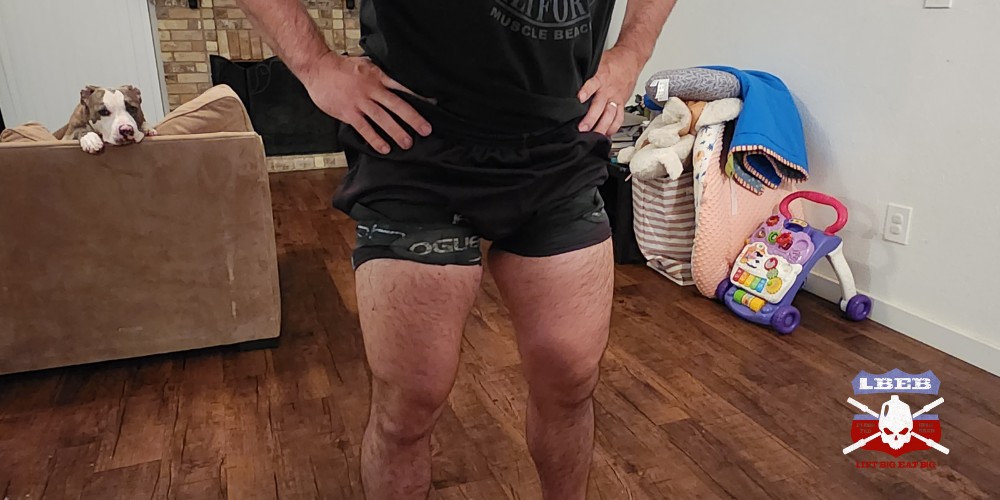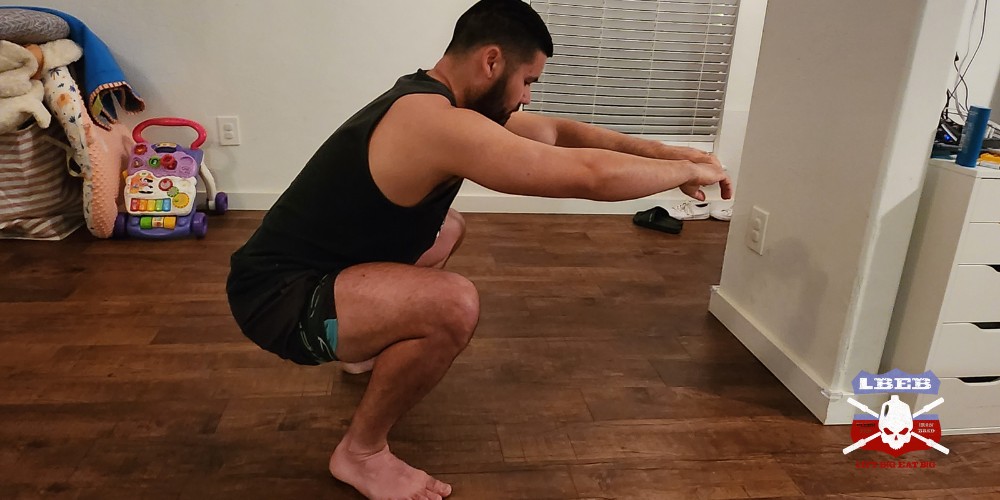Blood flow restriction training is a relatively new method for building slabs of muscle without heavy loads in your hands or on your back. You won’t see it used in your local gym, and it hasn’t escaped the professional sporting world into mainstream fitness… yet.
I’m taking you through everything you need to know to start implementing blood flow restriction training right now so you can become a muscular beast.
Table of Contents
What Is Blood Flow Restriction Training?
Blood flow restriction training, also known as occlusion training, involves tightening a cuff around the top of your arms or thighs to maintain arterial flow (blood coming to the muscle) while restricting venous return (blood leaving the muscle) [1].
It originated in Japan in the 1970s with Dr Yoshiaki Soto’s Kaatsu, hence why it was called Kaatsu training. Restricting blood flow aims to create a more anabolic environment to promote muscle hypertrophy without needing heavy loading.
But what is the advantage of using blood flow restriction protocols over traditional weight training for strength and size?
Blood Flow Restriction Training Benefits
Increased Muscle Size Without Heavy Loads
Multiple meta-analyses and individual studies have shown the efficacy of blood flow restriction training for building muscle. When low-load blood flow restriction training (20-30% 1RM) is compared to high-load resistance training (60-90% 1RM), similar gains in muscle mass are seen [2][3][4].
This has been shown to be equally effective in 20- to 80-year-old healthy adults regardless of age. There are many mechanisms theorized as to why blood flow restriction training works so well for building muscle. They likely all play a role in increased muscle size.
One is the downregulation of the myostatin gene. If you’ve seen pictures of overly muscular animals like pitbulls and cows, you’ve seen the effects of a myostatin gene deficiency. Overexpression of this gene reduces muscle mass.

Resistance exercise reduces myostatin gene expression acutely after exercise [6]. While acute anabolic enhancements after resistance exercise don’t necessarily translate to long-term improvements, it is theorized this may be a mechanism for greater muscle hypertrophy.
Blood flow restriction training reduces myostatin gene expression similarly to high load resistance training [7].
The other mechanisms theorized as primary mechanisms are cellular swelling, metabolic stress, and increased muscle fiber recruitment [8]. Cell swelling inhibits catabolism and promotes protein anabolism.
Metabolic stress is potentially one of the critical factors inducing muscle hypertrophy. It’s the build-up of metabolites within the muscle promoting an anabolic environment [9].
Occluding blood flow enhances metabolic stress by pooling blood within the muscle and the accompanying metabolites from energy production.
One study directly measured these mechanisms after blood flow restriction training and found increased metabolic stress, muscle swelling, and activation [11].
All of this means you can build muscle without heavy loading, making it a practical method when you have minimal equipment or have injuries stopping you from heavy resistance exercise.
Increase Muscle Strength With Light Loads
Blood flow restriction and strength gain are more controversial than increasing muscle mass. For example, previous meta-analyses suggest high load resistance training is superior for strength development over blood flow restriction training [3][4].
This is regardless of the strength test used, as you’d expect the high-load group to perform better during a 1RM test since they practice weekly with heavy loading versus light loads in the blood flow restriction condition.
Researchers put this down to neural adaptations from heavy loading, such as improved motor unit recruitment, firing rate, and synchronization [3]. In other words, more horsepower is being sent to the muscle.
However, the latest meta-analysis found low-load blood flow restriction training to be equally effective at improving strength as high-load resistance training in young to older adults [2].
Why this discrepancy?
Previous meta-analysis included studies using within-subject controls (e.g., exercising the right leg with blood flow restriction and the left leg without blood flow restriction as the control) or using non-randomized grouping.
The cross-education effect, where strength is gained in the trained opposite limb, means we may not get the true value of blood flow restriction [10]. Further, non-randomized studies may have selection bias.
So, this meta-analysis only included randomized control trials where one group performed blood flow restriction training and the other did not [2].
They found low-load blood flow restriction training to produce similar strength gains to high-load resistance training.
But that doesn’t mean you abandon high-load resistance training in favor of wrapping your legs and repping out light weights.
Combining low-load blood flow restriction training with high-load resistance training enhances strength further than either protocol alone [5].
Build Muscle & Get Stronger When Injured

Injury is where blood flow restriction training is used most and was its initial use case. There’s an excellent published case report of two patients with Achilles tendon ruptures [12]. Patient 1 was still limping 6 months after surgery and had limited push-off ability.
He performed leg and calf presses with the tourniquet cuff around the top of his thigh. After 5 weeks, he increases calf raise strength by 522% and power by 4475% during slow-speed calf raises.
He was able to walk without assisted devices and started a running program. Sounds like success to me. Patient 2 could not run 4 months post Achilles surgery due to weakness in the injured limb.
After 6 weeks of blood flow restriction, he improved calf raise strength by 55.8% and power by 68.8% during slow-speed calf raises. He was able to return to running and sports.
We also see reduced limb strength imbalances that occur when injured, making the recovery process faster [13].
It’s important to understand that these improvements likely wouldn’t have occurred to this magnitude as low load resistance training alone doesn’t increase strength to the same degree as when the limb is occluded [5].
Heavy resistance isn’t an option when recovering from injury and surgery. Light loads are tolerated well, and restricting blood flow provides the stimulus for adaptation.
Improve Muscular Endurance
An interesting study in national-level powerlifters found increases in type 1 muscle fiber size and number of capillaries [14]. This means an increased ability to buffer acidic waste products and an increased ability for the muscle to use oxygen, prolonging fatigue.
We also see a fatigue resistance effect with subjects performing more reps with 50% of their leg press 1RM [15].
No Muscle Damage
Even though measures of muscle hypertrophy increased from blood flow restriction training when performing the leg press with 30% 1RM, no muscle damage markers increased [11]. From my own experience, I’ve found an extreme burn during my sets and directly afterward.
Then, after a few minutes, I no longer have muscle pain. I don’t get delayed onset muscle soreness (DOMS) later in the day or the following day, even though the pump I got was unreal.
However, that’s not to say you’ll experience the same, especially if you’re untrained.
For example, this study had subjects perform 4 sets of leg extensions to failure with 20% 1RM, and one subject dropped out of the study with severe muscle soreness and couldn’t walk without crutches after the first session [14].
If you’re unaccustomed, you’ll have muscle damage even without blood flow restriction.
Blood Flow Restriction Drawbacks

Extremely Uncomfortable
Occluding blood flow isn’t a pleasant feeling. My first blood flow restriction training session had me quit after the first set.
I tied rubber elastic bands around the top of my arms and performed 25-30 band overhead triceps extensions supersetted with band biceps curls.
My arms were on fire; I had to take the bands off. I also decided to torture myself at 7:30 a.m. with blood flow restriction squats, which is a nasty way to start your morning.
To make occlusion training bearable, you can remove the pressure between each set and see similar gains as keeping it on during rest periods [15].
Lack Of Tendon & Bone Adaptation
Heavy loading is needed to increase bone density and tendon thickness [15]. As blood flow restriction protocols are typically performed with loads between 20-30% 1RM, you’re missing key adaptations needed for performance.
Hence, combining low-load blood flow restriction and heavy resistance training shows superior gains over one another [5].
Targets Type 1 Muscle Fibers
Targeting Type 1 muscle fibers is a pro and a con, depending on your primary goal. If your goal is maximizing strength and power output, you want to preferentially target Type II muscle fibers. If you’re a pure physique athlete, it’s not an issue, as you hit both types during different set protocols.
How To Do Blood Flow Restriction Training

You’ll need either specialized blood flow restriction cuffs or elastic bands like wrist wraps or voodoo floss bands. Proper cuffs allow you to standardize the pressure between limbs and sessions. Bands and wraps are a practical method when you don’t have cuffs.
If you’re using a band, wrap it to a 7 out of 10 tightness, which has been shown to be effective [14]. Check with the manufacturer for the cuffs, as pressure will depend on cuff width [17].
Tighten the bands around the top of the arms for upper body exercises and the top of the legs for lower body exercises. Depending on your skin color, your skin will turn red, which is a good sign you’re occluding blood flow.
You can test the tightness by pressing against your skin and releasing it. It should take approximately 3-4 seconds for the blood to come back. If it takes longer (over 6 seconds) for it to return, your cuffs are too tight.
Either keep the cuffs on for all sets of the exercise or remove them during rest periods if it’s too painful. I prefer keeping them on as I currently use bands and don’t want to wrap them each time. So once you’ve got the bands on, what do you do?
Blood Flow Restriction Training Protocols
There are two common protocols used within the research. One is taking 4 sets to failure with 20% 1RM. This is typically done on machine isolation exercises like the leg extension.
Expect to get over 50 reps for the first set and for it to dramatically drop for the subsequent sets.
Take 30-60 seconds rest between sets. The other protocol is the 30-15-15-15 method, where you perform 4 sets at 20-30% 1RM with 30-60 sec rest between sets.
This can be used on compound and isolation exercises and is commonly used with the leg press.
2-3 days per week maximizes training adaptations with blood flow restriction training [8].
Other Blood Flow Restriction Training Use Cases
Walking, running, and cycling are other training methods that have employed occlusion protocols. Interestingly, walking and cycling for 3-6 weeks with the blood flow restriction cuffs led to a 7-27% increase in strength and a 3-7% increase in muscle size [17].
Aerobic capacity is also improved in young, old, and trained individuals, making it perfect for maintaining strength, size, and conditioning when injured.
Is Blood Flow Restriction Training Safe?
Blood flow restriction is safe and effective and has been studied in populations from 20 – 80 years old. Minimal adverse events from blood flow restriction training are reported in the literature [17].
Summary
Blood flow restriction training is a novel, effective method for building strength and size without heavy-loaded resistance exercise. The use cases range from recovering from injury, building strength and size around injuries, and combining with heavy strength training for a potent hypertrophy stimulus.
The best case scenario is owning a pair of BFR cuffs as you can standardize the pressure. However, the budget version of using wraps and bands is a practical option that doesn’t require dropping cash.
References
1. Wortman, R. J., Brown, S. M., Savage-Elliott, I., Finley, Z. J., & Mulcahey, M. K. (2021). Blood flow restriction training for athletes: A systematic review. The American journal of sports medicine, 49(7), 1938-1944.
2. Grønfeldt, B. M., Lindberg Nielsen, J., Mieritz, R. M., Lund, H., & Aagaard, P. (2020). Effect of blood‐flow restricted vs heavy‐load strength training on muscle strength: systematic review and meta‐analysis. Scandinavian journal of medicine & science in sports, 30(5), 837-848.
3. Lixandrão, M. E., Ugrinowitsch, C., Berton, R., Vechin, F. C., Conceição, M. S., Damas, F., … & Roschel, H. (2018). Magnitude of muscle strength and mass adaptations between high-load resistance training versus low-load resistance training associated with blood-flow restriction: a systematic review and meta-analysis. Sports medicine, 48, 361-378.
4. Vechin, F. C., Libardi, C. A., Conceição, M. S., Damas, F. R., Lixandrão, M. E., Berton, R. P., … & Ugrinowitsch, C. (2015). Comparisons between low-intensity resistance training with blood flow restriction and high-intensity resistance training on quadriceps muscle mass and strength in elderly. The Journal of Strength & Conditioning Research, 29(4), 1071-1076.
5. Yasuda, T., Ogasawara, R., Sakamaki, M., Ozaki, H., Sato, Y., & Abe, T. (2011). Combined effects of low-intensity blood flow restriction training and high-intensity resistance training on muscle strength and size. European journal of applied physiology, 111, 2525-2533.
6. Drummond, M. J., Fujita, S. A. T. O. S. H. I., Takashi, A. B. E., Dreyer, H. C., Volpi, E. L. E. N. A., & Rasmussen, B. B. (2008). Human muscle gene expression following resistance exercise and blood flow restriction. Medicine and science in sports and exercise, 40(4), 691.
7. Laurentino, G. C., Ugrinowitsch, C. A. R. L. O. S., Roschel, H. A. M. I. L. T. O. N., Aoki, M. S., Soares, A. G., MANOEL NEVES, J. R., … & Tricoli, V. (2012). Strength training with blood flow restriction diminishes myostatin gene expression. Medicine & Science in Sports & Exercise, 44(3), 406-412.
8. Loenneke, J. P., Fahs, C. A., Rossow, L. M., Abe, T., & Bemben, M. G. (2012). The anabolic benefits of venous blood flow restriction training may be induced by muscle cell swelling. Medical hypotheses, 78(1), 151-154.
9. Schoenfeld, B. J. (2013). Potential mechanisms for a role of metabolic stress in hypertrophic adaptations to resistance training. Sports medicine, 43, 179-194.
10. Manca, A., Dragone, D., Dvir, Z., & Deriu, F. (2017). Cross-education of muscular strength following unilateral resistance training: a meta-analysis. European journal of applied physiology, 117, 2335-2354.
11. Wilson, J. M., Lowery, R. P., Joy, J. M., Loenneke, J. P., & Naimo, M. A. (2013). Practical blood flow restriction training increases acute determinants of hypertrophy without increasing indices of muscle damage. The Journal of Strength & Conditioning Research, 27(11), 3068-3075.
12. Yow, B. G., Tennent, D. J., Dowd, T. C., Loenneke, J. P., & Owens, J. G. (2018). Blood flow restriction training after Achilles tendon rupture. The Journal of Foot and Ankle Surgery, 57(3), 635-638.
13. Tennent, D. J., Burns, T. C., Johnson, A. E., Owens, J. G., & Hylden, C. M. (2018). Blood flow restriction training for postoperative lower-extremity weakness: a report of three cases. Current Sports Medicine Reports, 17(4), 119-122.
14. Bjørnsen, T., Wernbom, M., Kirketeig, A., Paulsen, G., Samnøy, L. E., Bækken, L. V., … & Raastad, T. (2018). Type 1 Muscle Fiber Hypertrophy after Blood Flow–restricted Training in Powerlifter.
15. Schwiete, C., Franz, A., Roth, C., & Behringer, M. (2021). Effects of resting vs. continuous blood-flow restriction-training on strength, fatigue resistance, muscle thickness, and perceived discomfort. Frontiers in Physiology, 12, 663665.
16. Bohm, S., Mersmann, F., & Arampatzis, A. (2015). Human tendon adaptation in response to mechanical loading: a systematic review and meta-analysis of exercise intervention studies on healthy adults. Sports medicine-open, 1(1), 1-18.
17. Patterson, S. D., Hughes, L., Warmington, S., Burr, J., Scott, B. R., Owens, J., … & Loenneke, J. (2019). Blood flow restriction exercise: considerations of methodology, application, and safety. Frontiers in physiology, 533.
